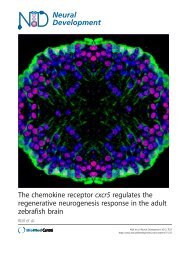Neural Development - BioMed Central
Neural Development - BioMed Central
Neural Development - BioMed Central
Create successful ePaper yourself
Turn your PDF publications into a flip-book with our unique Google optimized e-Paper software.
<strong>Neural</strong> <strong>Development</strong> 2009, 4:1<br />
http://www.neuraldevelopment.com/content/4/1/1<br />
Expression of NM23-X4 and other Xenopus family members in embryogenesis<br />
Figure 3 (see previous page)<br />
Expression of NM23-X4 and other Xenopus family members in embryogenesis. (A) Semi-quantitative RT-PCR analysis<br />
of NM23-X4 and NM23-X1 at stages 6, 9, 11, 15 and 18 of embryogenesis. Ornithine decarboxylase (ODC) was used as an<br />
internal control. (B) Whole-mount in situ hybridization of NM23-X4 with a probe containing the cDNA cloned in pBluescript<br />
as shown in the schematic. Expression is not detected until after gastrulation at neurula stages and with persistence in the head<br />
region. Shown are: (a) stage 3, lateral view, animal up; (b) stage 3, animal view (c) stage 18, dorsal view, anterior up; (d) stage<br />
18, anterior view, dorsal up; (e) stage 29, dorsal up, anterior right; (f) stage 32, with enlarged view marked in dashed line and<br />
shown in (g); (h) stage 35, with enlarged view marked in dashed line and shown in (i); (j) stage 41. ot, otic vesicle; ph, pharyngeal<br />
arches; e, eye. (C) Whole-mount in situ hybridization of NM23-X1, -X2 and -X3 at representative tadpole stage 33: (k) NM23-<br />
X1 and (l) NM23-X2 are ubiquitously expressed, while (m) NM23-X3 is localized in the head region. Sense control is shown in<br />
(n).<br />
NM23-X4 inhibits p27Xic1-mediated gliogenesis through<br />
their direct interaction<br />
Our results suggest that NM23-X4 negatively regulates<br />
p27Xic1 activity. In order to test this hypothesis, we cooverexpressed<br />
p27Xic1 and NM23-X4 in the retina by<br />
lipofection and analyzed the effect on gliogenesis. As<br />
reported previously, p27Xic1 strongly activates gliogenesis<br />
(Figure 6A). Interestingly, co-expression with NM23-<br />
X4 strongly inhibited this effect (Figure 6A). Other NM23<br />
family members, NM23-X1, -X2, and -X3, also inhibited<br />
p27Xic1-mediated gliogenesis, although the inhibition<br />
was weaker than that mediated by NM23-X4.<br />
In order to gain more insight into the NM23-X4 action, we<br />
examined the putative NM23-X4 interaction domain of<br />
p27Xic1. Mutational analysis showed that NM23-X4<br />
binds to two amino-terminal constructs of p27Xic1, NT<br />
(1–96) and 1–91, but not to the carboxy-terminal one<br />
(Figure 6B and data not shown). Interestingly, NM23-X4<br />
did not interact with the 1–30 construct or the 31–96 construct,<br />
which is sufficient for both cyclin/CDK binding<br />
and Müller cell inductive activity similarly to NT and 1–91<br />
constructs [13], suggesting that NM23-X4 binding<br />
requires an area covering both parts of 1–30 and 31–91.<br />
Also, the realization that the immunostained bands of NT<br />
and 1–91 are always stronger than that of the wild type<br />
suggested that the carboxy-terminal region of p27Xic1<br />
might negatively influence the binding between NM23-<br />
X4 and p27Xic1. We then analyzed the effect of NM23-X4<br />
and -X1 on gliogenesis mediated by p27Xic1 derivatives<br />
(Figure 6C). Interestingly, both NM23-X4 and -X1 effectively<br />
inhibited the glial-promoting effect of full length<br />
and NT constructs, while the effects of the 31–96 construct<br />
were hardly inhibited by these isoforms. These<br />
results imply that the inhibitory function of NM23 proteins<br />
requires their interaction with p27Xic1 and that<br />
NM23-X4 does not inhibit p27Xic1 activity downstream<br />
of p27Xic1. Consistent with this, NM23-X4 does not<br />
inhibit gliogenesis mediated by p16Xic2 (Figure 6D), with<br />
which it does not bind. Next, the effect of co-introduction<br />
of shX4-B and -B on gliogenesis was analyzed. Figure 6E<br />
shows that shX4-B does not activate gliogenesis when<br />
p27Xic1 is downregulated (in the presence of shXic1-B),<br />
indicating that activation of gliogenesis by shX4-B occurs<br />
in the presence of p27Xic1.<br />
Serine-150 and histidine-148 are required for the NM23-<br />
X4 activity<br />
We then tried to identify the residue(s) or domain(s) of<br />
the NM23 proteins important for the regulation of<br />
p27Xic1 activity. Some critical residues and domains of<br />
NM23-H1 have been identified previously (Figure 1B).<br />
Histidine-118 of NM23-H1 (histidine-148 of NM23-X4)<br />
is required for the NDPK and histidine-dependent kinase<br />
activities [36]. Serine-120 of NM23-H1 (serine-150 of<br />
NM23-X4) is also important for histidine dependent<br />
kinase activity [36]. The KPN loop forms part of the active<br />
center important for the kinase activity and mediates hexamer<br />
formation [37]. Therefore, three mutants of NM23-<br />
X4 (NM23-X4 H148C, S150G, and KPN) were constructed<br />
and their interaction with p27Xic1 and effects on<br />
p27Xic1-mediated gliogenesis were analyzed. As shown in<br />
Figure 6F, all three mutants interacted with p27Xic1.<br />
Interestingly, NM23-X4 H148C and S150G mutants did<br />
not inhibit p27Xic1-mediated gliogenesis, while KPN<br />
did (Figure 6G), suggesting that NDPK and/or histidine<br />
dependent protein kinase activities are required for regulation<br />
of p27Xic1 activity. This might also suggest that<br />
deletion of the KPN loop in the KPN mutant does not<br />
structurally abrogate the active center formation as is<br />
reported for the case of NM23-H1 [38].<br />
Overexpression of NM23 family members promotes<br />
gliogenesis<br />
Overexpression of NM23-X4 alone in the retina increased<br />
the proportion of Müller cells (Figure 7A–D). Staining<br />
against the Müller glial markers R5 and CRALBP verified<br />
the Müller cell identity of NM23-X4 expressing cells that<br />
presented a glial cell morphology (Figure 7E–J). Anti-calbindin<br />
and 39.4D5 staining was performed to visualize<br />
photoreceptor and ganglion cells in order to verify the<br />
phenotype and confirm the cell type percentages (Figure<br />
7K–P). Further analysis revealed that overexpression of<br />
NM23-X1, -X2, -X3, and -H1 also induced similar glio-<br />
Page 7 of 18<br />
(page number not for citation purposes)




